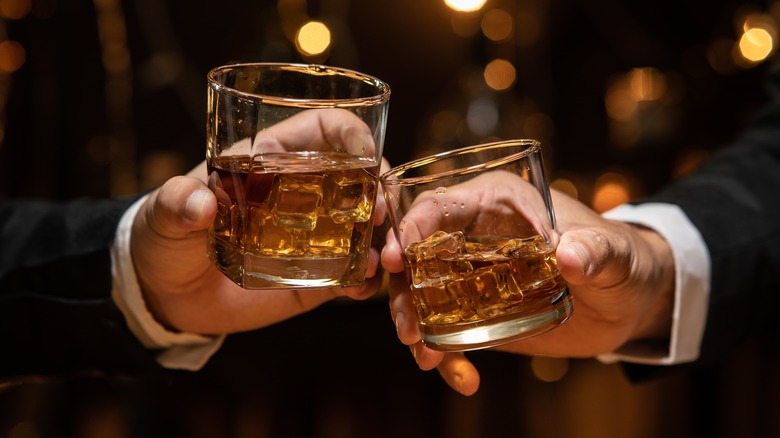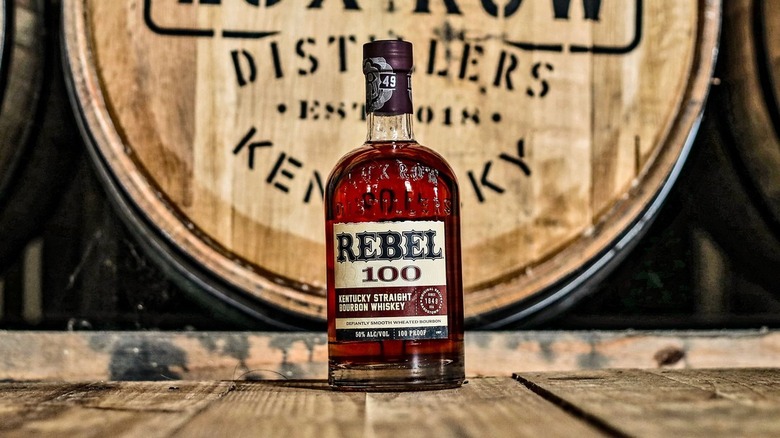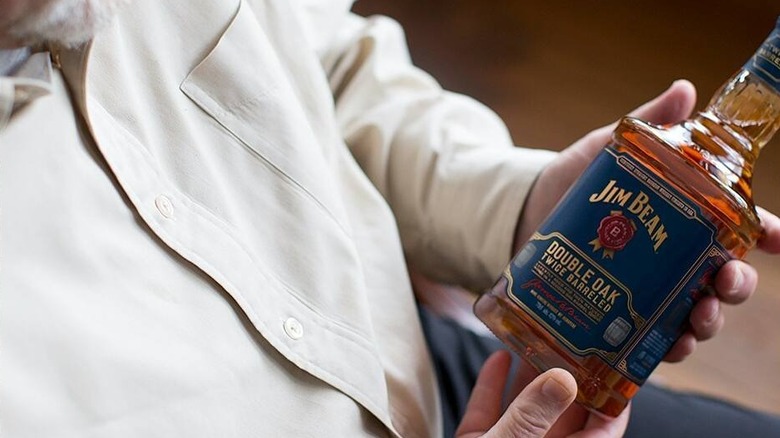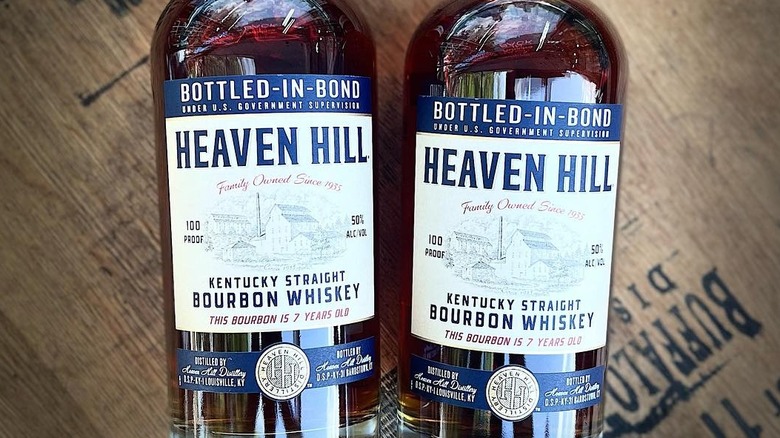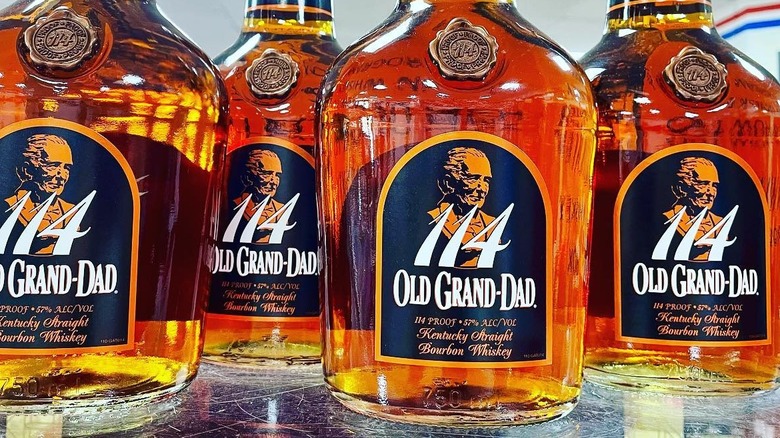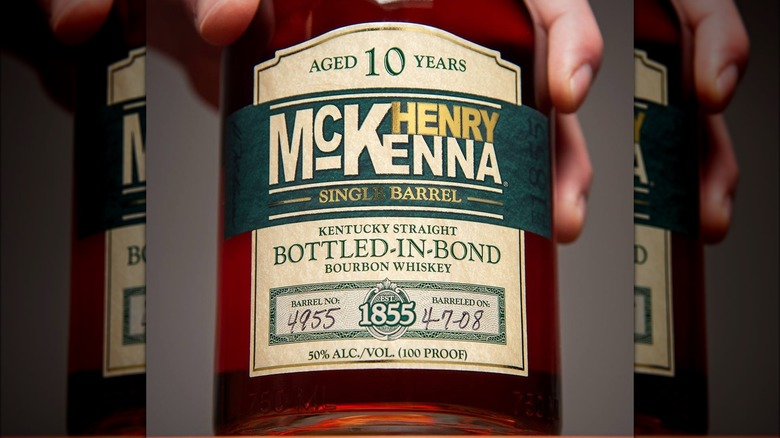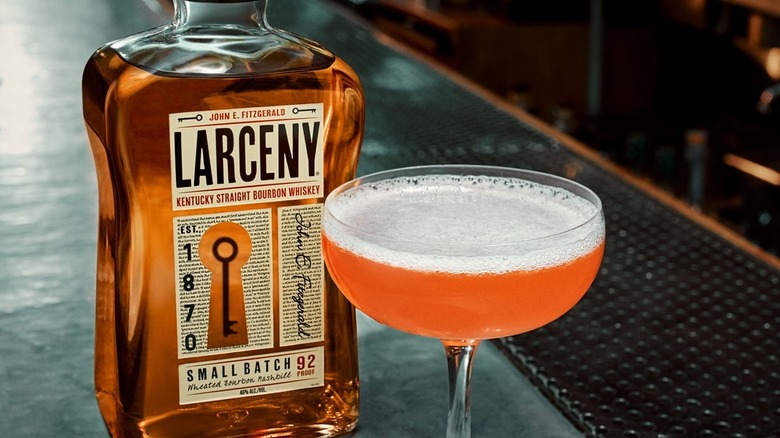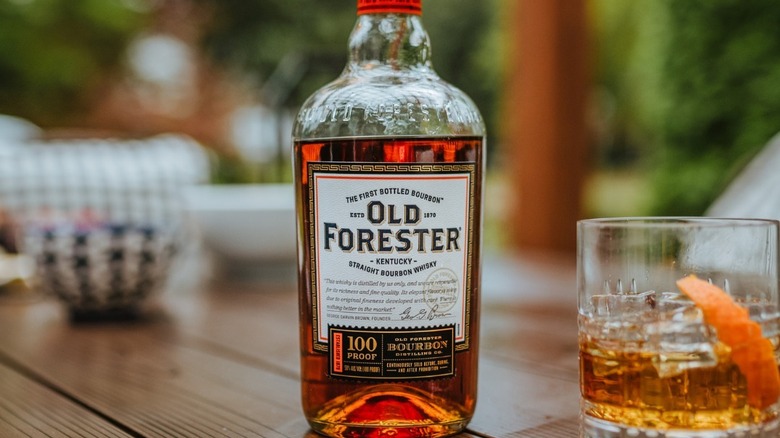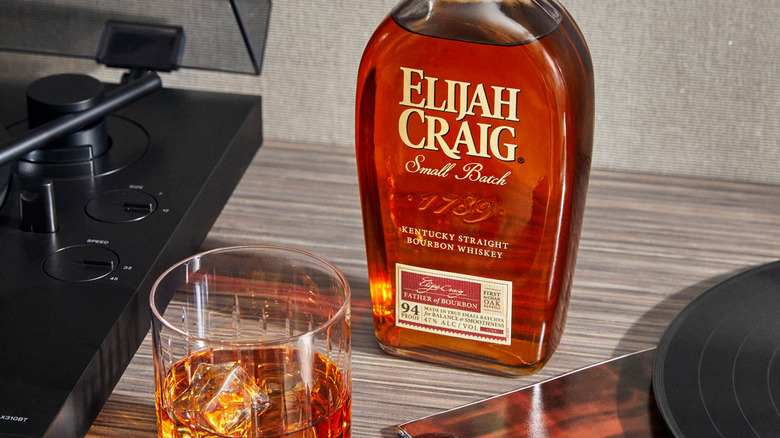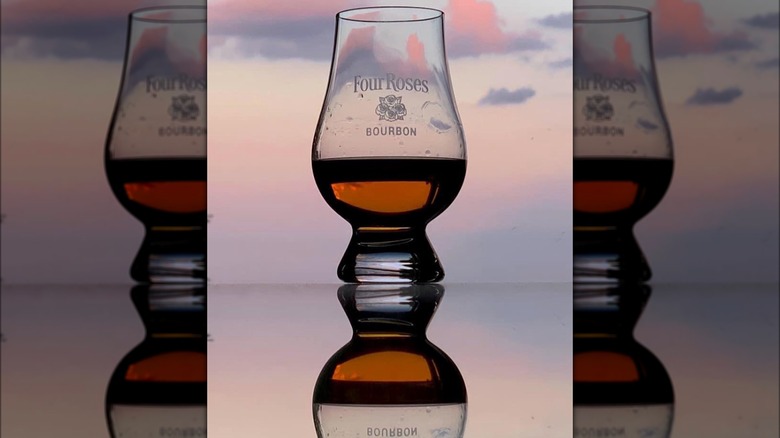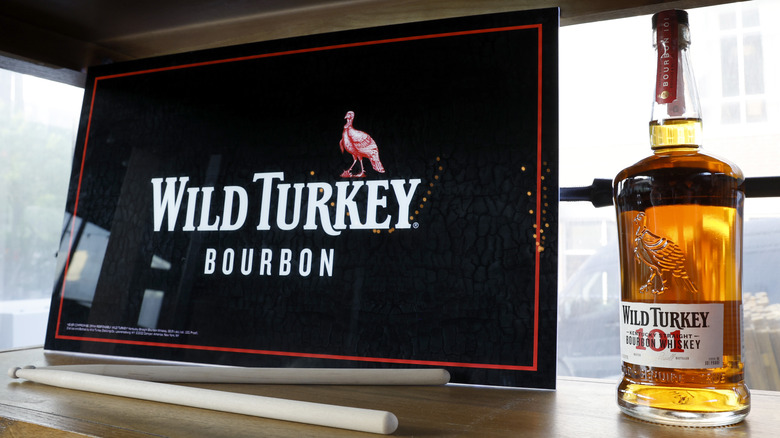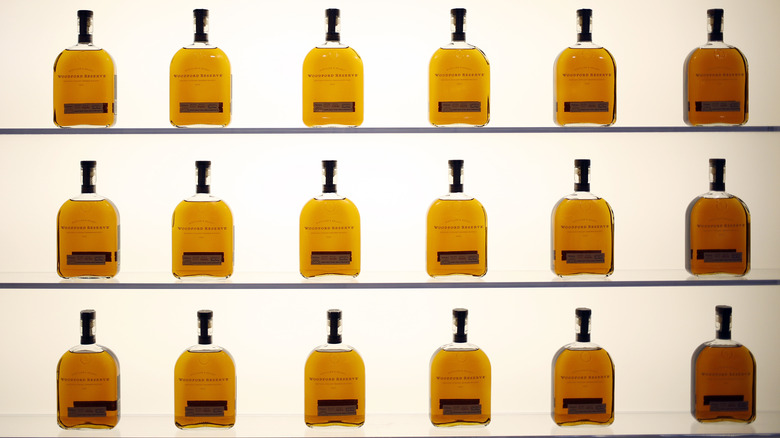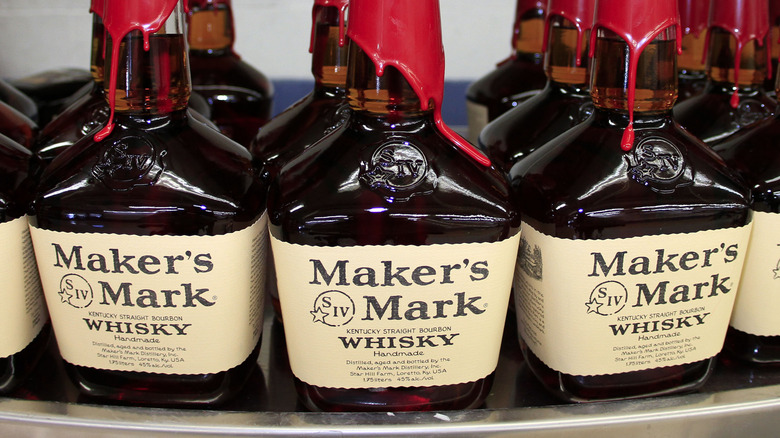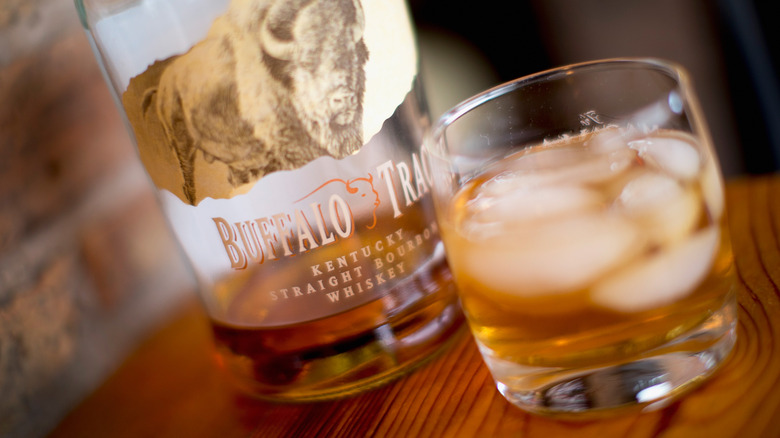13 Best Value Bourbons On Liquor Store Shelves
As America's Native Spirit, bourbon is a truly unique style of whiskey – born in Kentucky but enjoyed the world over. However, bourbon's ever-rising popularity has meant a global increase in demand. And that means a reduction in supply and a boost in cost for the consumer.
The bourbon distillation process is time-consuming, expensive, and subject to stringent manufacturing criteria. For example, aside from having to be produced in the United States, bourbon's mash bill has to consist of at least 51% corn — the grain responsible for bourbon's iconic sweetness — with no added flavorings. It also has to be aged for at least two years just to legally be called a bourbon, and premium whiskies usually need to be aged much longer than that.
While there are a number of craft distilleries across the U.S. making fantastic bourbons, as smaller operations, their costs and prices are inevitably higher, so it's hard to find any in the budget friendly range. That means we're primarily left with bourbons from the much larger, corporate distilleries if we're after a bottle for less than $35 — but there is a silver lining. Fortunately, because even the conglomerate-owned bourbon brands have to be based in the U.S., the majority are still producing world-class, great-value American whiskeys using techniques that have been passed down for generations.
Rebel Yell 100
Although Rebel Yell is now produced by Lux Row Distillers, a relatively new distillery based out of Bardstown, Kentucky, it has a long and storied heritage. The Rebel Yell brand was formed back in the 1930s, just a few years after the United States prohibition of alcohol was lifted, but the whiskey's original creators were putting their own spin on old-style bourbons as far back as the mid-19th century.
While bourbon's sweetness comes from the prominent corn in its mash bill, distillers would historically use rye to make up the difference. While rye makes bourbon taste spicier and more robust, it was the Stitzel-Weller distilling company that used wheat instead. The result was an earthier, creamier whiskey that's smoother and more accessible to bourbon drinkers.
Bottled at 50% ABV, Rebel Yell 100 is a bold, great-value bourbon that should be able to pick up for less than $25. It manages to strike a uniquely balanced profile — tantalizingly sweet caramel and vanilla notes from the corn and barrel-aging, a grain-forward smoothness from the wheat, but with a noticeable heat and a dry finish due to the higher alcohol content. While Rebel Yell 100 is an excellent sipping whiskey, a couple of ice cubes, splash of water, or your favorite mixer will make for a less intense drink.
Jim Beam Double Oak
Jim Beam is a name that goes all the way back to bourbon's inception, and despite the brand now being a part of the multinational Japanese brewing and distilling company, Suntory, it's still produced in its birthplace of Kentucky. Most bourbon drinkers are familiar with the ubiquitous Jim Beam White Label, a sweet and mellow whiskey that isn't bad per se, but certainly lacks the complexity of a more premium whiskey.
However, with Jim Beam Double Oak, Beam Suntory has managed the impressive feat of elevating certain flavor elements to a higher standard without ramping up the price using a pretty simple trick. While all bourbons must legally be aged in newly charred oak barrels, Double Oak gets aged once and then transferred into another new barrel. By doubling the amount of contact time the whiskey gets with a fresh barrel, Double Oak has a more intense, spiced oak flavor that compliments the classic vanilla and toffee aromas.
One of the main criticisms of White Label is that it's too thin and lacks the complexity of a sipping whiskey; however, Double Oak manages to address this issue while only adding a few extra dollars onto the bottle price, generally retailing for $25.
Heaven Hill Bottled-in-Bond
Produced by Heaven Hill Distillery, a name renowned in the world of bourbon since its founding in 1935, the eponymous Bottled-in-Bond is a whiskey that pays homage to the brand's heritage as well as a historic designation of superiority.
It probably comes as little surprise that quality control of alcoholic spirits in the late 19th century wasn't quite as strict as it is today. To improve standards and guarantee the authenticity of American whiskey, the United States federal government enacted the Bottled-in-Bond Act in 1897 with criteria that distillers had to meet for the seal of approval — and the tax incentive that went along with it. To earn the designation, whiskey has to be distilled in a single distillery during one distillation season, aged in a federally bonded warehouse for a minimum of four years, and bottled at 50% ABV.
Not only does Heaven Hill Bottled-in-Bond still adhere to these strict criteria, but it's a whiskey that embodies the tradition of authentic bourbon-making, resulting in a balanced profile of vanilla, honey, and charred oak for around $40, which is an incredible value for a bourbon of this caliber.
Old Grand-Dad 114
Another offering from Beam Suntory, Old Grand-Dad 114 comes from the distillery's range of high-rye whiskies and — like many Beam Bourbons — is an expression that pays tribute to one of the company's late patriarchs, Basil Hayden.
Old Grand-Dad 114 — with an ABV of 57% — stands out in the world of lower-priced, higher-strength bourbons, especially as the extra alcohol heat can make rye-forward whiskeys taste too rough. Old Grand-Dad 114 has a pleasant bite, and is balanced, dry, and earthy, with a nutty quality that's often associated with Jim Beam whiskeys. While it's a great value bourbon, selling for around $30 a bottle, it does lack some viscosity and sweetness, showing a need for maturity.
If you like your bourbon with a kick, it's perfectly drinkable neat or with a few ice cubes, but to get the most out of Old Grand-Dad 114, you're better off trying it in a classic whiskey cocktail, like an Old-Fashioned or a Manhattan.
Henry McKenna Sour Mash
The Henry McKenna brand is another of Heaven Hill Distillery's whiskey ranges, named after an Irishman who immigrated to the United States armed with a unique distilling expertise — specifically, a dedication to aging bourbons before bottling. While there are great things to be said about the whole McKenna selection, the Sour Mash is the best value and can cost as little as $14 per bottle.
To the uninitiated, sour mash refers to a distilling method that uses a pre-fermented grain mash, which usually includes spent grains from a previous distillation. You can think of it like sourdough bread — a sourdough or sour mash adds more acidity to the mix. In whiskey-making, this gives the distiller more control over the pH levels of their bourbon for a more consistent, balanced result.
In this case, it makes the Henry McKenna Sour Mash bourbon extremely approachable. It features classic caramel, vanilla, and oak aromas, and a sweet, toasted grain profile with a hint of spice. It's an easy-drinking bourbon if you're getting used to taking your whiskey neat, but also has enough character to work well in lighter refreshing cocktails like a Whiskey Smash or Kentucky Mule.
Larceny Small Batch Bourbon
It's a testament to the Heaven Hill distillery that they're able to consistently produce excellent, low-cost bourbons, and Larceny Small batch is another steal at the $20 mark. This particular whiskey was named in honor of John E. Fitzgerald, a gentleman who was considered to be a master distiller back in the 1870s, but remained something of an enigma to his contemporaries.
The legend was that Fitzgerald was a master distiller from Ireland, like McKenna, but the truth is certainly more entertaining. He was actually a United States Treasury agent and one of the only people legally allowed to hold keys to the bourbon warehouses. It would appear Fitzgerald had a taste for fine whiskey and was often discovered lurking behind barrels which, when checked, were notably emptier than they should have been.
History aside and, well, misdemeanors apparently forgiven, Larceny Small Batch has a corn and wheat-heavy mash bill that results in a sweet, smooth bourbon with nuanced flavors of sweet caramel, peanut, and a light, floral touch. Like the Henry McKenna, Larceny is an approachable bourbon for sipping neat, but can also be used to balance complex cocktails, like a Paper Plane.
Old Forester 100
Although Old Forester's parent company — the Brown-Forman Corporation — is not what you'd call small, Old Forester bourbon was their very first product, going all the way back to 1870. In fact, this particular bourbon can make a few unique claims.
First, the whiskey's distillers initially sold Old Forester as a medical product, which made it the only bourbon sold exclusively in glass bottles, which automatically boosted customers' perception of its quality. It was also one of the few distilleries allowed to continue making whiskey for medicinal purposes throughout prohibition, making it the longest continuously sold bourbon in history. If you're wondering what the difference is between "medicinal" bourbon and regular bourbon, the answer is: Absolutely nothing. The medical field was a bit different 150 years ago.
At 50% ABV — Old Forester 100 has a punchy aroma with hints of butterscotch and cocoa, and the rye in the mash adds nutmeg and clove spice to the oak and ripe apple sweetness. It's a bourbon that's bold enough to stand out in flavorful cocktails too, especially a Hot Toddy or Boulevardier, and a bottle shouldn't set you back more than around $25.
Elijah Craig Small Batch
Now a part of the Heaven Hill family, Elijah Craig Small Batch is another bourbon named after one of the most distinguished figures in United States whiskey history. A Baptist minister from Virginia, Craig is commonly — although not communally — believed to be the Father of Bourbon.
Some claim Elijah Craig was the first distiller to age his whiskey in charred oak barrels, the process that gives bourbon its rich, smooth flavor and is now a legal requirement of its production, but it's unlikely we'll ever know for sure. However, we do know that his legacy lives on in the quality of the Elijah Craig range.
Until 2016, The 47% Small Batch edition of Elijah Craig used to bear a 12-year age statement – the year on the bottle being the age of the youngest whiskey in the blend. However, due to dwindling stocks from increased demand, Heaven Hill dropped the age statement so they could add younger whiskeys and stretch their supplies.
Fortunately, the gamble was worth it because the difference is negligible, and the price has stayed low with bottles costing a little more than $30. The newer edition is perhaps a touch less oak-heavy, but it's still super smooth with prominent vanilla and a light smokiness. While it always tastes great neat, Elijah Craig's creamy finish also makes it an interesting addition to a dessert cocktail or "hard" milkshake.
Four Roses
The story of Four Roses is one that's difficult to verify with certainty. However, the most common tale is that the brand was first registered by Paul Jones Jr. in 1888.
Although Paul Jones Jr. wasn't a whiskey maker, he was an astute businessman who sold well-crafted bourbon blended from the whiskeys of other distilleries. During prohibition, Jones Jr. purchased the Frankfort Distilling Corp which, like Old Forester's distillers, held a license to produce medicinal bourbon. As a result, the Four Roses brand was able to cement itself as one of America's premier whiskeys.
Four Roses bourbon has had ups and downs over the years. After falling out of favor in America, it became a huge hit in Europe and Asia — at one point, it was an export-only product and you couldn't even buy it in the United States. Fortunately, Four Roses is back on liquor store shelves and one of the best-value bottles around at just $20. The high ratios of corn and rye create a harmonious sweet-spice profile of oaky vanilla, but it also has floral quality, likely due to Four Roses' proprietary yeast strains. Ultimately, Four Roses is versatile enough to drink any way you like — neat, on the rocks, with a mixer, or in a lighter whiskey cocktail.
Wild Turkey 101
Despite being one of today's most recognizable whiskey brands, Wild Turkey was originally created in 1869 by the Ripy family as a nameless bourbon, sold to wholesalers to be blended and relabeled. In fact, it took almost 70 years for the bourbon to become its own brand.
Around 1940, an employee for Austin Nichols — a buyer of the Ripy's bourbon started bringing samples on wild turkey hunting trips to share with his friends. After being continually asked for more of "that wild turkey bourbon," a brand was born. However, Wild Turkey's fate truly changed in 1954, when master distiller — "The Buddha of Bourbon" — Jimmy Russell came aboard. Both Jimmy and his son, Eddie, are Kentucky Bourbon Hall-of-Famers who have spent their entire careers studying and perfecting the science and art of distilling at Wild Turkey.
Consequently, Wild Turkey's bourbon range is consistently excellent value for your money, with Wild Turkey 101 being a stand-out choice, costing less than $25 a bottle. Despite the 50.5% ABV and high rye content, the heat and spice offer a peppery warmth without being overbearing, while the sweeter characteristics still have room to shine. Wild Turkey 101 is a robust sipping whiskey, but if you find it too unapproachable, it's perfect for amplifying an Old Fashioned or Whiskey Sour.
Woodford Reserve
Like Wild Turkey, Woodford Reserve is a comparatively new addition to the bourbon world, launched back in 1996; however, the distiller's history goes back much further. Woodford Reserve is now owned by Brown-Forman Co., but the distilling site has been in use since 1812 and is designated a National Historic Landmark.
Although Woodford Reserve is a relative newcomer, centuries of whiskey-making knowledge and heritage have helped it build an excellent reputation as superb-value bourbon. At 45.2%, it has a rich mouthfeel without too much heat, while the barrel char adds notes of brown sugar, cinnamon, burnt orange, and dried fruit.
Despite its lower price of around $35, Woodford tastes like a premium bourbon that's smooth and rounded enough to enjoy neat, yet versatile enough to use in almost any whiskey cocktail. However, considering the mint julep is the official beverage of the Kentucky Derby, and Woodford Reserve is the event's official sponsor, it's a combination everyone should try once.
Maker's Mark
Although Maker's Mark doesn't have a history as long as many bourbons on this list, it's managed to become a household name since the Samuels family began producing it in 1953. Bill Samuels Sr. — an engineer turned distiller — decided he wanted to improve the standard of bourbon and was bottling his own creation five years later.
While Samuels Sr.'s attempt was a success, much of Maker's Mark brand recognition can be credited to his wife, Margie, who was responsible for the bourbon's iconic bottle shape, label, and hand-dipped wax cap. The brand is now owned by Beam Suntory, but the Samuels family is still responsible for distilling the world-famous whiskey.
What's always set Maker's Mark apart from other bourbons is the use of soft red winter wheat as a secondary grain, a result of Samuels Sr.'s fastidious early experimentation. By using wheat instead of rye, and a sour mash, Maker's Mark is a uniquely well-rounded bourbon. With vanilla and oak at the forefront and a creamy finish, and costing around $30 a bottle, there are not many approachable American whiskeys at such an attractive price point.
Buffalo Trace
Buffalo Trace is just the most recent name of one of the oldest continually operating distilleries in the United States, with origins going back to the late 18th century. Although ownership and management of the distillery have changed multiple times since then, the Buffalo Trace distillery has been associated with some of the most distinguished figures in bourbon history.
During the 19th century, American whiskey icons George T. Stagg and E.H. Taylor, Jr. turned the distillery into one of the best in the country, while Colonel Albert B. Blanton kept it alive through prohibition and two world wars. The distillery is now owned by the Sazerac Company, and while the company itself hasn't been passed down through a single family, its bourbon-making heritage is almost unparalleled.
The bourbon that bears the Buffalo Trace name wasn't introduced until 1999 but has earned dozens of accolades thanks to its superb versatility and the fact it's a uniquely exceptional base for whiskey cocktails. Considering the quality and history contained in each bottle, the fact Buffalo Trace is so inexpensive, usually costing less than $25 per bottle, is nothing short of remarkable.

